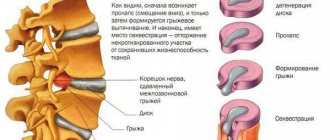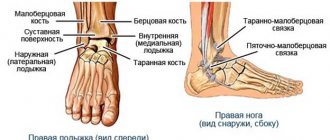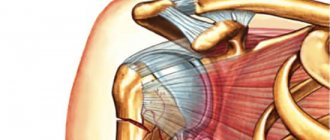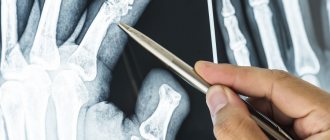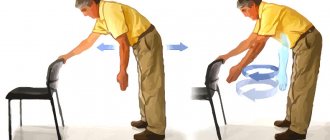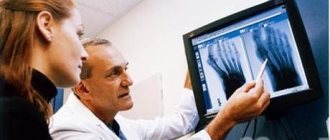The main complaints in case of a fracture are pain at the site of injury, deformation of the limb, and limited mobility. If the integrity of the skin is compromised, bleeding, pallor, rapid heartbeat are observed, and a state of shock may occur. Temperature at a fracture is a variable sign, in most cases it indicates serious complications. Therefore, if a fever occurs, especially in a child, it is necessary to call a doctor. Only an experienced specialist will be able to determine whether this is a protective reaction of the body to damage or the onset of a serious illness. Sometimes it is a variant of the norm and indicates the body’s reaction to injury and the formation of a hematoma.
The body's response to a fracture
Under the influence of a traumatic factor in some situations, bone fragments disrupt the integrity of soft tissues and skin. This leads to cell death, rupture of blood vessels and infection in the wound. An inflammatory reaction occurs at the site of damage, which has the following manifestations:
- acute pain reaches its maximum at the time of injury and is associated with irritation of nerve fibers. If the injured limb is at rest, the pain decreases, and with the slightest movement it intensifies;
- swelling occurs due to increased vascular permeability. Inflammatory factors, which are called mediators, migrate to the site of injury, after which the liquid part of the blood enters the intercellular space. Visually, the damaged area will look swollen;
- redness is associated both with vasodilation and with disruption of the integrity of small capillaries, which leads to subcutaneous hemorrhages and bruises;
- The temperature increase is local in nature. If this is an uncomplicated fracture, the skin will be slightly warmer upon palpation. This reaction is a natural defense mechanism against damage. The expansion of arterioles and the influx of warmer blood, activation of biochemical processes leads to an increase in temperature at the fracture site;
- Due to injury, the mobility of a certain area is limited. Loss of function is the final symptom of the inflammatory response.
Mechanisms of temperature increase during fracture
Bone damage is a stress reaction for a person; the body tries to cope with the situation and protect itself. Many people are interested in the question of whether there can be a temperature during a fracture. The answer is simple: yes, it can. But there are different reasons for this condition.
If the temperature is low, does not exceed 38 °C, disappears after a few days, the patient’s condition does not worsen, these are manifestations of a traumatic disease and are a variant of the norm. When a fracture occurs, the functioning of the central nervous system is disrupted. At first, excitation processes predominate, the person does not feel pain, is excited, rushes about, this state is caused by the release of adrenaline into the blood. Next, a phase of inhibition occurs, the patient reacts sluggishly to others, and loss of consciousness is possible. An increase in temperature complements the clinical picture. Most doctors believe that this is the body's way of responding to injury.
Note! If a large bone is damaged, the temperature reaction will be more pronounced. The number of fragments also matters; the more there are, the higher the likelihood of an increase in temperature.
A high temperature after a fracture may indicate serious illness. The likelihood of developing such a condition is higher if the fracture is open and the wound has become infected. As a rule, health worsens a few days after the injury. Infectious complications, entry of adipose tissue into the bloodstream are accompanied by high fever. The patient's condition is serious, first aid should be provided as quickly as possible.
Why does the temperature rise when a leg is injured?
A leg fracture is less common than an arm fracture, but the symptoms are similar in most cases. How a person will feel depends on the severity of the fracture and the correct first aid. If you feel a sharp or dull pain, but the fracture is closed, you can safely use the knowledge and rules of applying a splint and wait for an ambulance to arrive.
It is considered normal if the victim has a slight temperature, about 37.5. It may go away in a week. If the temperature rises sharply, up to 40 degrees, you must immediately consult a doctor to prevent the development of gangrene.
Causes
An increase in temperature during a fracture is observed in both adults and children. The degree of fever depends on the state of the person’s immune system, the presence of concomitant diseases, and the type of fracture. The main reasons for the rise in temperature include:
- immune system response to damage;
- osteomyelitis;
- fat embolism;
- entry of bacteria into the wound with the subsequent development of sepsis.
Hand injury
Arm fractures are the most common. The hospital will be able to use x-rays to determine where the injury is and what its nature is. When an arm is broken, the victim may notice symptoms such as swelling and edema of the limb, deformation of the bones and their crunching, and paralysis of the fingers may also occur. If the fracture is closed, then it is enough to remember the rules for applying a splint and immobilize the limb. The arm should be fixed in the elbow position. If all steps are performed correctly, complications and fever can be avoided.
Post-traumatic osteomyelitis
If the integrity of the skin is compromised during a fracture, the risk of microbes entering the wound increases several times. In a healthy body, cells of the immune system destroy bacteria and viruses, preventing the development of inflammation. In people with weakened immune systems, the infection can spread unhindered throughout the body. This is also facilitated by comminuted fractures, large blood loss, significant damage to soft tissues, and untimely assistance.
Microbes entering the wound begin to multiply, and over time, damage to bones and soft tissues is observed. The term osteomyelitis refers to an inflammatory process in bone tissue that occurs with periods of inflammation and remission. The disease has the following manifestations:
- High fever. The temperature can reach 40 °C, the general condition progressively worsens: the patient is worried about weakness, loss of appetite, chills.
- The child may experience convulsions and bursting pain.
- Nausea and vomiting are symptoms of intoxication and indicate a severe course.
- The pain in the damaged area intensifies and may be throbbing or shooting.
- Swelling increases, the skin becomes red and hot to the touch.
- If pus is released from the wound, this is a sign that bacteria have entered the body.
- Movements are severely limited and accompanied by severe pain.
The clinical picture of osteomyelitis may be blurred. In childhood, the disease is severe, signs of intoxication are most pronounced, and convulsions may be observed. If a child develops a fever due to a broken arm, it is necessary to urgently call a doctor. The sooner treatment with antibacterial drugs is started, the greater the chance of recovery.
Bone fractures in children
The leading principle is the conservative method of treatment (94%). In most cases, a fixing bandage is applied. Immobilization is carried out with a plaster splint, usually in the average physiological position, covering 2/3 of the circumference of the limb and fixing two adjacent joints. A circular plaster cast is not used for fresh fractures in children, since there is a risk of circulatory disorders due to increasing edema with all the ensuing consequences (Volkmann's ischemic contracture, bedsores and even necrosis of the limb).
During treatment, periodic x-ray monitoring (once a week) of the position of bone fragments is necessary, since secondary displacement of bone fragments is possible.
Traction is used for fractures of the humerus, shin bones and mainly for fractures of the femur. Depending on the age, location and nature of the fracture, adhesive plaster or skeletal traction is used. The latter is used in children over 3 years of age. Thanks to traction, displacement of the fragments is eliminated, gradual reposition is carried out and the bone fragments are held in the reduced position.
For bone fractures with displacement of fragments, one-stage closed reduction is recommended as early as possible after the injury. In particularly difficult cases, reposition is performed under periodic X-ray control with radiation protection for the patient and medical personnel. Maximum shielding and minimal exposure allows for repositioning under visual control.
The choice of pain relief method is of no small importance. Good anesthesia creates favorable conditions for repositioning, since the comparison of fragments should be done in a gentle way with minimal tissue trauma. These requirements are met by anesthesia, which is widely used in hospital settings. In outpatient practice, reposition is performed under local or regional anesthesia. Anesthesia is carried out by injecting a 1% or 2% novocaine solution into the hematoma at the fracture site (at the rate of 1 ml per one year of the child’s life).
When choosing a treatment method for children and establishing indications for repeated closed or open reduction, the possibility of self-correction of some types of remaining displacements during growth is taken into account. The degree of correction of the damaged limb segment depends both on the age of the child and on the location of the fracture, the degree and type of displacement of the fragments. At the same time, if the growth zone is damaged (during epiphysiolysis), as the child grows, a deformation may appear that was not there during the treatment period, which should always be remembered when assessing the prognosis.
Spontaneous correction of the remaining deformity occurs the better, the younger the patient is. The leveling of displaced bone fragments in newborns is especially pronounced. In children under 7 years of age, displacements for diaphyseal fractures are allowed in the length range from 1 to 2 cm, in width - almost across the diameter of the bone and at an angle of no more than 10°. At the same time, rotational displacements cannot be corrected during growth and should be eliminated. In children of the older age group, more accurate adaptation of bone fragments is necessary and it is necessary to eliminate deflections and rotational displacements. For intra-articular and periarticular fractures of the bones of the extremities, accurate reduction is required with the elimination of all types of displacement, since unresolved displacement of even a small bone fragment during an intra-articular fracture can lead to blockade of the joint or cause varus or valgus deviation of the limb axis.
Surgical intervention for bone fractures in children is indicated in the following cases:
- with intra- and periarticular fractures with displacement and rotation of the bone fragment;
- with two or three attempts at closed reduction, if the remaining displacement is classified as unacceptable;
- with interposition of soft tissues between fragments;
- with open fractures with significant damage to soft tissues;
- in case of improperly healed fractures, if the remaining displacement threatens permanent deformation, curvature or stiffness of the joint;
- for pathological fractures.
Open reduction is performed with special care, gentle surgical access, with minimal trauma to soft tissues and bone fragments and is completed mainly by simple methods of osteosynthesis. Complex metal structures are rarely used in pediatric traumatology. Most often, a Kirschner wire is used for osteosynthesis, which, even when carried out transepiphyseally, does not have a significant effect on bone growth in length. The Bogdanov rod, CITO, Sokolov nails can damage the epiphyseal growth cartilage and are therefore used for osteosynthesis for diaphyseal fractures of large bones. For improperly fused and improperly fused bone fractures, false joints of post-traumatic etiology, compression-distraction devices of Ilizarov, Volkov-Oganesyan, Kalnberz, etc. are widely used.
The time frame for consolidation of fractures in healthy children is shorter than in adults. In weakened children suffering from rickets, hypovitaminosis, tuberculosis, as well as with open injuries, the periods of immobilization are extended, since the reparative processes in these cases are slowed down.
With insufficient duration of fixation and early loading, secondary displacement of bone fragments and re-fracture are possible. Ununited fractures and pseudarthrosis in childhood are an exception and, with proper treatment, usually do not occur. Delayed consolidation of the fracture area can be observed with insufficient contact between fragments, interposition of soft tissues, and with repeated fractures at the same level.
After the onset of consolidation and removal of the plaster splint, functional and physiotherapeutic treatment is indicated mainly for children with intra- and periarticular fractures, especially when movement in the elbow joint is limited. Physical therapy should be moderate, gentle and painless. Massage near the fracture site, especially with intra- and periarticular injuries, is contraindicated, since this procedure promotes the formation of excess callus and can lead to myositis ossificans and partial ossification of the joint capsule.
Children who have suffered injury near the epimetaphyseal zone require long-term follow-up (up to 1.5-2 years), since injury does not exclude the possibility of damage to the growth zone, which can subsequently lead to limb deformity (post-traumatic deformity of the Madelung type, varus or valgus deviation of the limb axis, segment shortening, etc.).
Postoperative osteomyelitis
The disease occurs after osteosynthesis, skeletal traction, and surgery to compare bone fragments. The reason is violations of sterility rules during surgery, incorrect selection of antibiotics, as a result of which microorganisms easily enter the wound. The risk of infectious complications is higher with comminuted fractures, open injuries, displacement of fragments, and significant damage to soft tissues.
As a rule, doctors associate the occurrence of inflammation with several factors:
- decreased immune response;
- large volume of surgical intervention;
- non-compliance with the rules of antisepsis and asepsis during surgery;
- the patient’s refusal to take antibiotics in the postoperative period, ignoring the prescription of drugs or the wrong combination.
If you do not seek help in a timely manner, necrosis (death) of the bone and surrounding tissue occurs, and gangrene develops. Treatment in this case is only surgical - amputation of the limb. There is also a risk of sepsis when bacteria, as well as their toxins, enter the blood in large quantities from the site of the primary inflammatory process.
Fat embolism
Another reason why the temperature rises after a fracture is fat embolism. This complication occurs when large bones are damaged: femur, humerus. Adipose tissue enters the vascular bed and spreads with the bloodstream. When the diameter of the veins or arteries becomes smaller, their lumen becomes clogged with fatty tissue.
Fever in this case is a minor complaint; other symptoms come to the fore. The patient's condition deteriorates sharply. Symptoms will depend on the location of the fat clot. Symptoms often appear after moving or not following prescribed bed rest. It is necessary to pay attention to the following manifestations:
- shortness of breath, difficulty breathing, cough may indicate blockage of the pulmonary arteries;
- tachycardia and interruptions in heart function occur;
- the temperature rises to 39 °C, accompanied by dizziness, loss of consciousness is possible;
- in 50% of cases, pinpoint rashes are observed on the upper half of the body, hemorrhages on the mucous membranes;
- After a few days, the volume of urine decreases, and acute renal failure may occur.
Temperature during a fracture of a leg or other large bones is an unfavorable prognostic sign. If the fever does not go away after 1-2 days or any of the above symptoms are observed, you should go to the hospital.
What to do if the temperature rises?
If a patient has a fever after a fracture, it is necessary to call an ambulance or take the victim to the hospital on your own, following safety recommendations. Taking medications should be avoided, since pain relief can blur the clinical picture and make diagnosis difficult.
Once a diagnosis has been made, antipyretic medications can be taken to reduce the temperature. For children, it is better to use paracetamol-based products. The choice of dosage forms is quite wide, so you can choose the appropriate remedy for each age.
It is better to give Paracetamol or Panadol in syrup to young children. For older children, tablets are suitable. If a child refuses to take tablets or syrup, you can use rectal suppositories (for example, Cefekon), but they are only suitable for children under 5-6 years of age.
Adults can lower their temperature with Paracetamol 500 or Ibuprofen tablets.
Anyone can break a leg or arm, no matter how careful they are. Temperature is one of the symptoms of pathology, so you should treat it calmly. In most cases, it goes away on its own. If this does not happen, you should definitely seek medical help, since prolonged excess of the permissible values may indicate serious complications that require immediate treatment.
Diagnostic features
The main task of the doctor is to determine the main cause of the increase in temperature and prescribe appropriate treatment. The diagnostic process consists of the following steps:
- careful history taking. It is necessary to clarify all complaints, when they arise, what alleviates the condition, what medications the patient took, how much time has already passed. The doctor also takes into account the type of fracture, the presence of fragments or displacement, the degree of damage to soft tissues, and assesses the risk of complications;
- Next, the doctor examines the damaged area, determines the presence of pus or other discharge, and checks the range of motion. Additionally, it is necessary to pay attention to the condition and color of the skin, rashes, and the functioning of the cardiovascular and respiratory systems. Fine wheezing or decreased breathing may indicate a fat embolism;
- A general blood test allows you to determine the presence of inflammation and the degree of blood loss;
- biochemical analysis indicators allow you to assess the condition of the kidneys and liver;
- An ECG is mandatory;
- using CT or MRI, you can identify the main cause of fever: the presence of a fat embolus in the lungs or an inflammatory process in the bone;
- Sometimes a chest x-ray may be required to rule out pulmonary pathology.
High fever after a fracture
Persons with reduced immunity are at risk. These may be patients who have suffered from infectious diseases or suffering from diseases that require a lot of effort to restore the body. Pregnant and lactating women fall into this category. While carrying a child, all the forces of the female body are aimed at maintaining pregnancy and developing the fetus, so if a fracture occurs during this period, the intoxication will be quite strong.
Females are especially susceptible to increased body temperature during pregnancy.
Particularly vulnerable categories also include children under 7 years of age. During this period, the immune system is actively developing, so fractures at an early age are always accompanied by a high temperature (within 38 degrees) and are difficult to treat.
Intoxication and fever are accompanied (most often) by fractures in patients who:
- suffer from alcohol or drug addiction;
- smoke;
- undergo long-term treatment with potent drugs (antibiotics, hormonal medications);
- suffer from osteoporosis.
In some cases, temperature may be a consequence of inflammatory processes in the body that have a chronic course, so in order to correctly determine the cause of its increase, you need to contact a specialist.
Treatment
Treatment tactics will differ depending on the cause of the disease. It is not recommended to lower the temperature yourself, as this can complicate the diagnosis process.
An increase in temperature to low-grade levels (not higher than 38 °C) without additional symptoms may indicate a person’s body’s reaction to injury. In this case, the condition should improve in a few days, there is no danger to life.
Tactics for managing patients with osteomyelitis
If the bone is involved in the pathological process, surgical intervention cannot be avoided. The surgeon, after a thorough examination of the patient, reveals the source of inflammation. Next, the condition of the tissue is assessed, the pus is removed, and the wound is washed several times. All non-viable tissues and sequesters must be removed.
After the operation, the patient is prescribed powerful antibacterial and anti-inflammatory therapy. Medicines are administered into a vein in the form of injections and droppers; the use of topical drugs is indicated. If the temperature does not subside, antipyretics (paracetamol, ibuprofen) are used.
Help for patients with embolism
Treatment of fat embolism is a complex process. Patient management tactics depend on the severity of the disease. First of all, it is necessary to provide oxygen support. Next, the blood composition is corrected, cells are protected from free radicals, and dehydration occurs with increased intracranial pressure. In parallel, antibacterial drugs are prescribed in a loading dose together with glucocorticosteroids.
Prevention
Preventing fever is much easier than treating the disease. If a fracture occurs, there are some guidelines to follow to reduce the risk of serious complications.
Basic recommendations:
- adequate pain relief and correction of blood loss are the primary tasks in case of bone damage;
- Primary wound treatment is the main way to prevent infection. If the fracture is open, it is necessary to carefully treat the wound, excise all damaged tissue, and prescribe antibiotics;
- you must follow the rules for applying plaster. If the bandage fits too tightly to the body, the blood supply to the tissues is disrupted, swelling and a local inflammatory reaction occur;
- Early surgical stabilization of fractures prevents the development of fat embolism. It is necessary to compare the fragments and fix them in this position as soon as possible (on the first day after the injury);
- After osteosynthesis or skeletal traction surgery, you cannot stop taking antibiotics on your own.
